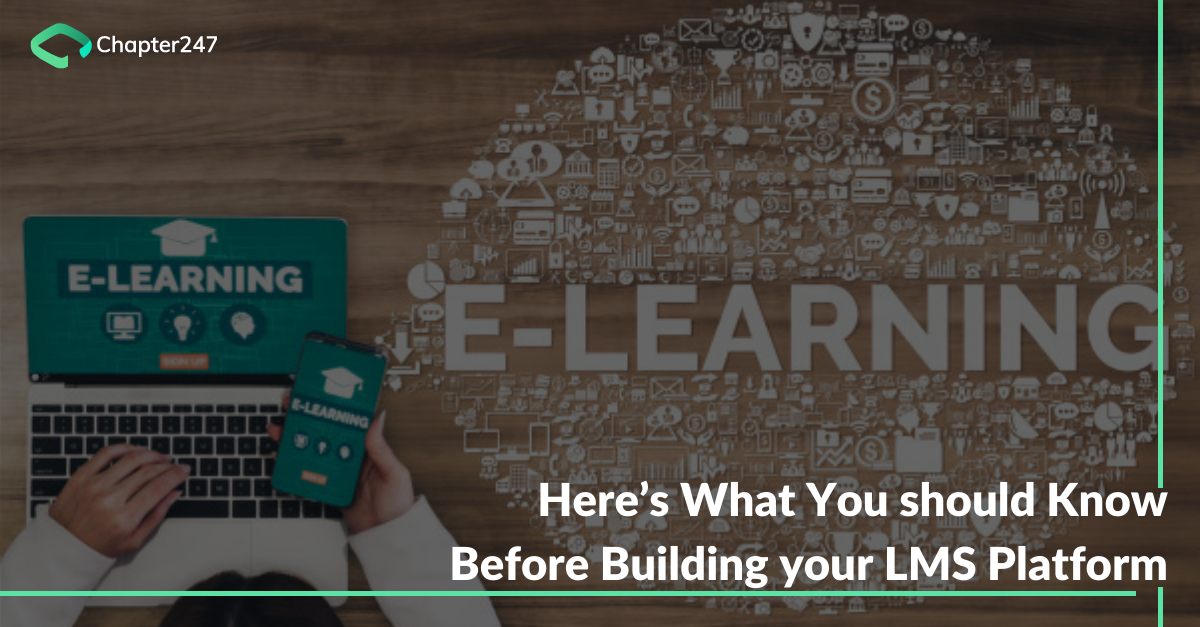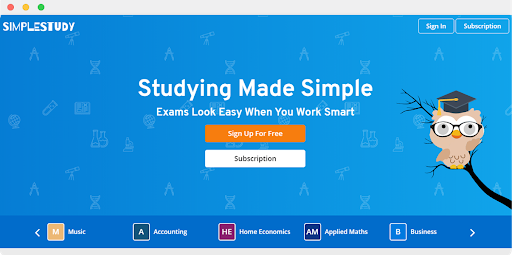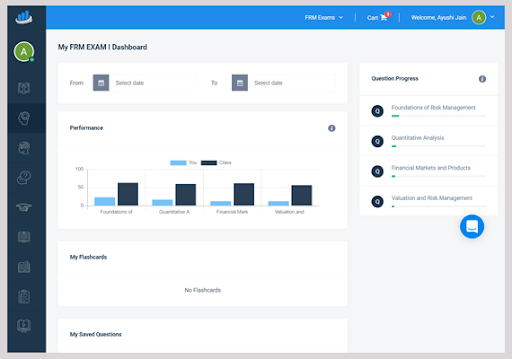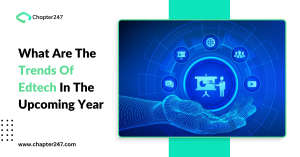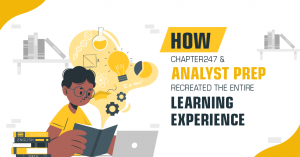By the end of 2020, the global eLearning market will reach $31 billion. The breakneck speed of changes in tech trends is the reason for LMS solutions and the eLearning platforms being the busiest in the world of technology nowadays. LMS space is prepped with disruptive technologies like AI, VR, Big-data to keep pace with the trends.
Why LMS
LMS and digital learning technology offer the most compelling and extensive benefits. It provides educational and other enterprises the convenience of integrating eLearning content in a single place giving learners unhindered access to learning materials. It removes the burden of manual tracking of learner performance. A custom LMS solutions company will incorporate custom features you wish to integrate into your software which an off-the-shelf will not provide. Some reasons why LMS is a worthy investment are:
- It organizes eLearning content all in one place
- Provides unlimited access to eLearning material
- Massive expansion in users/learners base
- Helps in easy tracking of learner performance so that the tutors can then design how to progress with a poor learner
- Takes a downward leap in L&D costs
- A much-better learning outcome along with increased ROI that sticks for long-term
- Integrates social experience
- Encourages forums and discussions with students all across the world
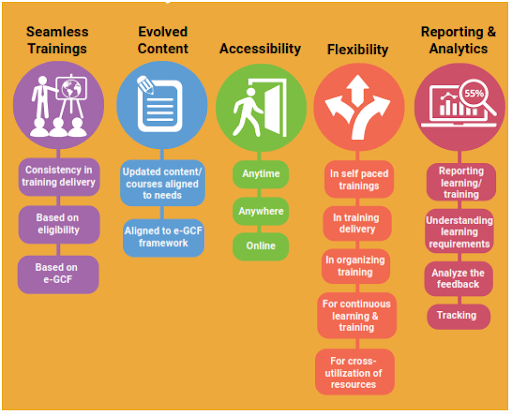
Source: NeGD
Your LMS should have these necessary modules
User and role management– An important module responsible for user authentication. It has several pre-configured roles like educators, administrators, learners. It also gives the convenience to add more roles if the need arises.
Course Management – One LMS will have several courses lined up, the course management module will help you reach the course that you are looking forward to accessing and managing.
Activity Management – This is the core of any LMS software solution. Managing learning activities come under course management which simply means that the course you choose will have activities below it. These activities are learning tools that could be in the form of PPT, documents, audios, video clips, external links to resources. One course usually has more than one activity.
Learning Path- This is the course delivery engine of an LMS. It is a collection of courses under a program or a subject. This module is absolutely a must-include module as it helps in saving time as a path is defined to achieve a learning goal.
Repository – This is the central location to manage the learning objects. They cannot be made local to the course for reuse and also to avoid any sort of duplication.
Certificate management – The results are obviously managed through this key module. The results of the quiz or an activity or an assessment are documented, collated, and presented in the form of certificates or even Grade sheets.
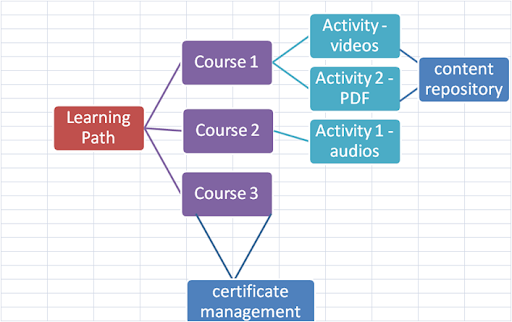
Learning Dashboard – This is a key feature that discusses the learning progress of the learner with the help of diagrams, graphs, illustrations, and numbers that will help track progress. It is nothing but the visualization of learning data.
Differentiating features to make a winning LMS
Easy to use – A great LMS interface means that the users should find it intuitive and user friendly. Ease of use is a must-have LMS feature.
Integration – Another important feature that will differentiate you from your competition is the ability of the LMS to share data with other systems within the enterprise. You might want to integrate it with these systems:
- Human Resource Information system
- Enterprise Resource planning
- Student Information system
- CRM and so forth
Content Management – When you compare LMS solutions you will realize that content management is quite basic but a very important component of LMS. If you take a look at this closer, this can be one factor that keeps one above the competition. Some necessary questions you need to ask your eLearning solutions development company are:
- Will the LMS support the latest standards of Elearning?
- Will uploading existing documents, videos, links, and assessments to web content be easy if it is hosted somewhere else?
- Will the LMS allow the curriculum as well as the learning resources to be organized into a learning path that makes logical sense?
- Will the sharing of learning materials across different courses and paths be possible?
Mobile learning-Learning on the go is the new buzz concept that LMS brings. It means delivery of education materials and learning support on any hand-held device like a phone or a tab. Responsive design is just the beginning of mobile learning support. Mobile learning is highly interactive and also delivered in shorter chunks. In one of the surveys, it was clear that a majority of learners preferred their learning to be broken down into simpler segments that would lead to more engagement and discussions.
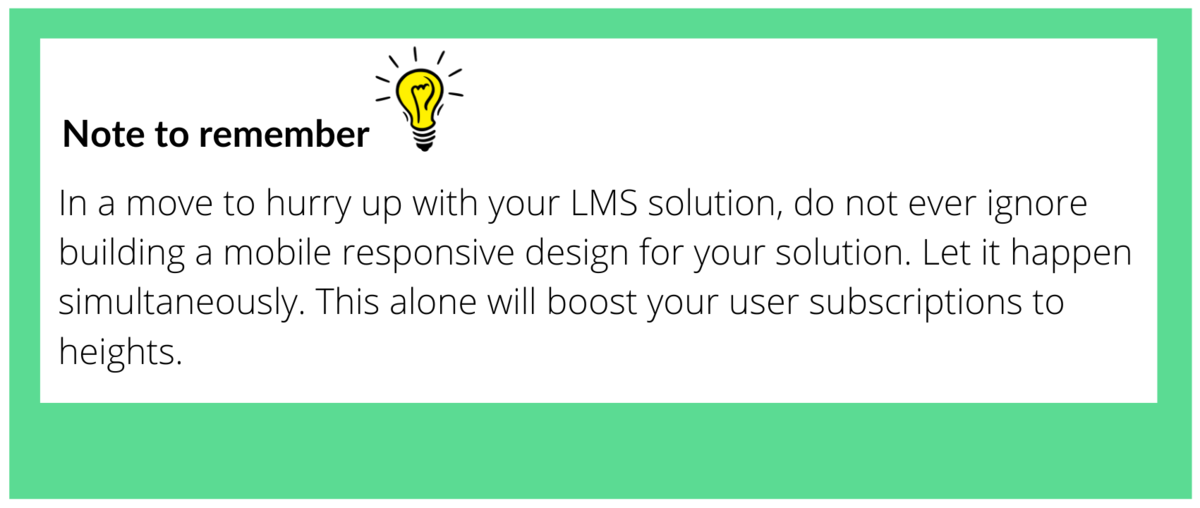
Support for Blended learning – What happens when the best way for the learner is to learn offline? In such cases, LMSes should support blended learning. Offline learning events also should be tracked, recorded, and assessed just like they do in the case of online learning. Some of the functionalities that should be a part of offline learning should be:
- Event registration like workshops and seminars
- Support for synchronous and asynchronous learning
- Combining offline learning with a learning path
- Support for documentation as well as tracking offline certifications and qualifications
Testing/ Assessment – Now since you are trying to understand everything there is to know about LMS, your constant interaction with LMS specialists has to be nothing short of inquisitive. For every must-have feature, several questions have to be asked to the LMS solution provider. Testing and assessment options have to be flexible in an LMS. The relevant things you need to tick-off in your next scrum meeting are:
- Whether the system is supporting Pre-tests and pro-tests?
- Is there support for formative assessments if there is a need?
- Can random questions be pulled in any order for the test?
- Type of questions supported
- Are the learner’s complete assessment portfolios stored for an indefinite time?
Case study watch
Digital learning is a space that is heavily invested upon yet, the adoption rates are not much encouraging. Students are used to the idea of conventional forms of education delivery until they come across something as promising as Simple Study. SimpleStudy is an intuitive custom eLearning and self-assessment solution that empowers students to evaluate their exam preparation leveraging advanced technology. Experience our very own journey of how we ensured the product LMS solution became a successful reality! |
Reporting and Tracking
Augmented reporting capabilities is another key feature that can be segmented into different reports like
- Learning item reports which track how many learning items have been covered by the learners.
- Learner path reports that track the progress of the learner across the learning path
- Exam reports that help the organization analyze exam performance to ensure and establish the effectiveness of the learning system.
Social integration and forums
An LMS makes it easy to integrate social learning into an eLearning strategy. Links to FB, Twitter, LinkedIn groups can be made. Online forums also can be initiated for a discussion most beneficial for holistic learning.
Notifications
LMS should provide real-time updates on the courses. It should have an in-built system that sends a notification for updates like webinars, online discussion forums initiation, a new update on course in the form of simple text, images, and action buttons.
Other differentiating factors include
- Easy and simple to use API for smooth integrations of external systems
- Utilization of AI for personalized learning that helped determine the learning behavior of the user and deliver modules that are object-based.
- Adopting standards for excellent interoperability and excellent tracking of learners’ progress.
- Many studies have depicted that learners are able to recall only 10% of what they have read and 20% of what they hear. But if learning is accompanied by visuals, the learning effectiveness goes up by 30%. But the best part is when gamification is included in the learning process the learning enhances to 90%! The gamified learning environment has proven to be better in terms of learning outcomes.
Case study watch- Analyst Prep We were required to provide a responsive web and a hybrid mobile application infused with a Student-centric tracking system to check progress in the forms of heavy and visual analytics. The quizzes too had to be customized based on the subscription model of students. Our team of LMS experts, developers, and L&D engineers boosted the application with advanced analytics made possible with complex algorithms and a feature-rich dashboard! Click here to see how the client clocked in a 169.5% growth in its user subscriptions with this Chapter247 built application |
How much will it cost to build an LMS
The investment required for building an LMS will depend on whether you want to build it from scratch or use a ready-made product like a SaaS LMS. If you require an LMS that works the way you want it, then a custom-built solution works the best and easy.
The below-given table gives you a comparative analysis of LMS construction between a local agency and an outsourcing software development firm.
| Local – US | Outsourced | |
| Number of hours required to build MVP and Prototype | 600- 800 hours | 500- 700 hours |
| Cost per hour | $100 to $300 | $ 50 to $200 |
| Cost in the first month | $20 k to $60 k | Half of the local charges |
| Cost of team | Additional | None |
Another way to go about it is to use an existing LMS platform to customize it based on your needs. Cloud-based platforms will charge a license fee or charge as per your use. Self-hosted platforms will cover the periodic licenses and provide free licenses. Once it is bought, you can have access to all the features that LMS provides. But there could be customization limitations and if you need full functionalities, you will have to spend a lot on additional software and set-up fees. The price range for this could be anywhere between $10,000 – $25000.
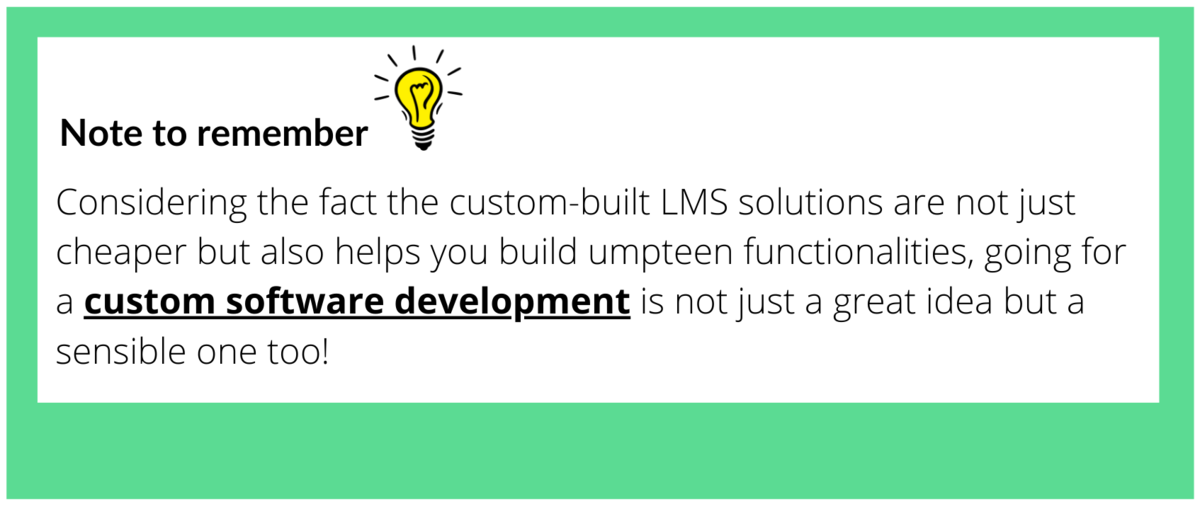 Summing up
Summing up
An LMS solution is extremely important for your business now, especially with the pandemic mess! It will make learning more efficient and will ensure the productivity of all types of learners enhance. Chapter247 will help you design a system that speaks your language
If you have a jaw-dropping idea for an LMS solution, we are ready to be blown away by it!
Contact us to convert it into reality.


